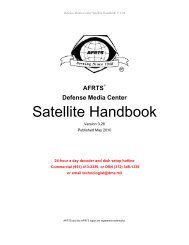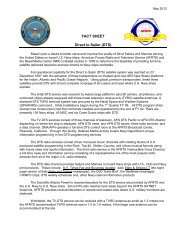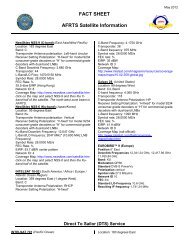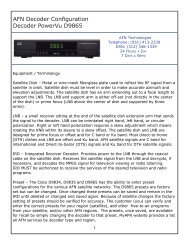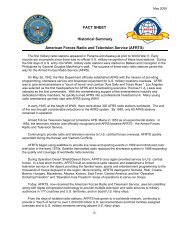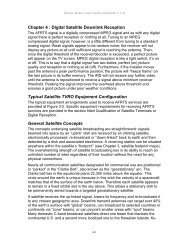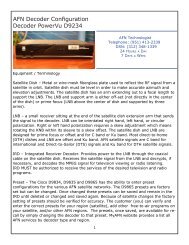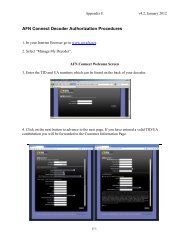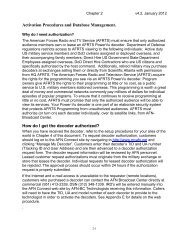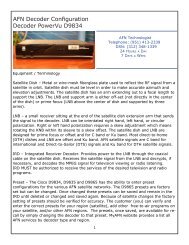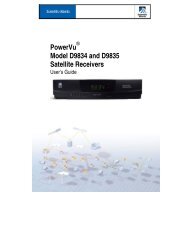Cisco D9865 Satellite Receiver Installation and Operation Guide
Cisco D9865 Satellite Receiver Installation and Operation Guide
Cisco D9865 Satellite Receiver Installation and Operation Guide
You also want an ePaper? Increase the reach of your titles
YUMPU automatically turns print PDFs into web optimized ePapers that Google loves.
Safety Precautions, Continued<br />
19. Replacement Parts: When replacement parts are required, be sure the service<br />
technician uses replacement parts specified by <strong>Cisco</strong>, or parts having the same<br />
operating characteristics as the original parts. Unauthorized part substitutions<br />
made may result in fire, electric shock or other hazards.<br />
20. Safety Check: Upon completion of any service or repairs made to this product,<br />
ask the service technician to perform safety checks to determine that the product<br />
is in safe operating condition.<br />
21. Outdoor Antenna Grounding: If an outside antenna or cable system is<br />
connected to this product, ensure that the antenna or cable system is properly<br />
grounded to provide protection against voltage surges <strong>and</strong> built-up static<br />
charges. Appropriate sections of the National Electrical Code (NFPA 1990)<br />
provide information with respect to proper grounding of the mast <strong>and</strong><br />
supporting structure, grounding of the lead-in wire to an antenna discharge<br />
unit, connection to grounding electrodes, <strong>and</strong> requirements for the grounding<br />
electrode (see <strong>Satellite</strong> <strong>Receiver</strong> <strong>and</strong> <strong>Satellite</strong> Antenna <strong>Satellite</strong> Antenna<br />
Grounding).<br />
<strong>Satellite</strong> <strong>Receiver</strong> & <strong>Satellite</strong> Antenna Grounding<br />
Before you can operate your satellite receiver system, both the satellite receiver<br />
chassis <strong>and</strong> the satellite antenna LNB connection(s) must be properly grounded. For<br />
information about grounding your satellite receiver, also referred to as “receiver”,<br />
<strong>and</strong> satellite antenna follow:<br />
Grounding the receiver: The receiver ground connection is made from the shield 1)<br />
conductor attached to the RF coaxial cable “F” connector (rear panel RF IN input) to<br />
an external grounding rod via a receiver/antenna grounding block. A separate<br />
grounding wire connects the grounding block (<strong>and</strong> the satellite antenna LNB<br />
grounding block) to the grounding rod.<br />
Grounding the LNB <strong>and</strong>/or VHF/UHF antenna: The antenna ground connection is<br />
made from the satellite LNB/antenna ground <strong>and</strong>/or the VHF/UHF terrestrial<br />
antenna discharge unit to an external grounding rod via a receiver/antenna<br />
grounding block.<br />
General grounding information: The actual ground/cable connections made<br />
depend on your site installation requirements, <strong>and</strong> on the type of satellite antenna<br />
<strong>and</strong>/or VHF/UHF terrestrial antenna you have. If your satellite antenna<br />
installation includes a dual-port LNB, both RF coaxial cables must be routed to the<br />
grounding block. When connecting RF coaxial antenna cables to the grounding<br />
block, looping the antenna cables as shown in the accompanying figure helps to<br />
direct moisture away from the grounding block. Always choose the shortest route<br />
possible when connecting RF coaxial cables to the receiver/antenna grounding<br />
block <strong>and</strong> when connecting the grounding wire(s) to the grounding rod.<br />
1)Multi-str<strong>and</strong> (braided) shield surrounding the center conductor of the coaxial cable.<br />
4035197 Rev C <strong>D9865</strong> <strong>Satellite</strong> <strong>Receiver</strong> <strong>Installation</strong> <strong>and</strong> <strong>Operation</strong> <strong>Guide</strong> vii



